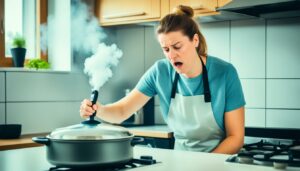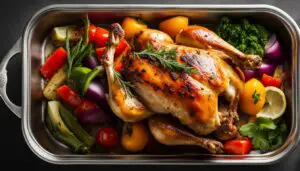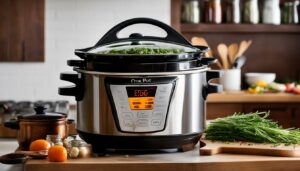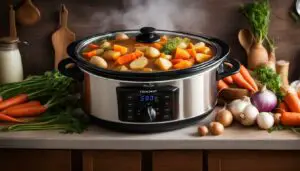Originally posted on March 26, 2024 @ 7:42 pm
Can you change a slow cooker recipe from low to high? Can you adjust slow cooker settings to modify the cooking time? These questions often arise when using a slow cooker. Many believe that slow cookers can only operate on low heat for extended periods of time, but what if there was a way to convert recipes and prepare meals more quickly? In this article, we will explore the possibility of converting slow cooker recipes from low to high, providing you with the flexibility and convenience of shorter cooking times.
When it comes to slow cookers, understanding the settings and knowing how to adjust them is crucial. Whether you want to convert a recipe or simply make adjustments to your cooking style, having a good grasp of the slow cooker settings is key. In the following sections, we will delve into the details of converting cooking time, factors to consider, and tips for successful conversion. By the end, you will be equipped with the knowledge to confidently modify slow cooker recipes to suit your needs.
Contents
- 1 Understanding Slow Cooker Settings
- 2 Converting Cooking Time
- 3 Factors to Consider
- 4 Tips for Successful Conversion
- 5 Printable Conversion Chart
- 6 Extend Cooking Time on Short-Cooking Recipes
- 7 Converting High Cook Time to Low Cook Time
- 8 When to Use Short-Cooking Recipes
- 9 Conclusion
- 10 FAQ
- 10.1 Can I change a slow cooker recipe from low to high?
- 10.2 How do I adjust the slow cooker settings?
- 10.3 How can I modify the cooking time in a slow cooker?
- 10.4 What factors should I consider when converting a recipe from low to high in a slow cooker?
- 10.5 What are some tips for successfully converting a slow cooker recipe from low to high?
- 10.6 Is there a printable conversion chart available for slow cooker recipes?
- 10.7 Can I extend the cooking time on short-cooking recipes in a slow cooker?
- 10.8 How do I convert a high cook time recipe to a low cook time in a slow cooker?
- 10.9 When should I use short-cooking recipes in a slow cooker?
- 10.10 What are some key points to keep in mind when converting slow cooker recipes from low to high?
- 11 Source Links
Key Takeaways:
- Converting slow cooker recipes from low to high heat can be done by adjusting the cooking time and temperature settings.
- Understanding the differences between low and high settings is crucial for successful recipe conversion.
- Factors such as the specific slow cooker brand, ingredient quantity, and recipe requirements should be considered when making adjustments.
- Following simple tips, such as chopping ingredients uniformly and adding certain ingredients at specific times, can contribute to a successful outcome.
- A printable conversion chart can be a handy tool to reference when modifying slow cooker recipes.
Understanding Slow Cooker Settings
When it comes to slow cookers, understanding the different settings is crucial for successful recipe conversion. These versatile appliances typically offer two temperature settings: low and high. By familiarizing yourself with these settings and their implications, you can easily adjust the slow cooker heat level and modify the slow cooker temperature to suit your cooking needs.
Let’s delve into the details:
The Low Setting
When you set your slow cooker to the low setting, it cooks food at a lower temperature over a longer period of time. This gentle heat allows flavors to develop and meats to become tender. The low setting is ideal for recipes that require slow and steady cooking, such as stews, roasts, and soups. It’s perfect for busy individuals who want to let their meals simmer throughout the day while they attend to other tasks.
The High Setting
On the other hand, the high setting on a slow cooker achieves a higher temperature in a shorter period of time. This setting is great for recipes that need to be cooked more quickly, such as certain cuts of meat or dishes with a shorter cooking time. It’s a convenient option when you’re in a time crunch and still want to enjoy the benefits of using a slow cooker.
By adjusting slow cooker heat levels and modifying the slow cooker temperature settings, you can adapt recipes to your desired cooking time and ensure that your meals turn out just right.
Now that we’ve covered the basics of slow cooker settings, let’s move on to the next section where we explore the process of converting cooking time in a slow cooker.
Converting Cooking Time
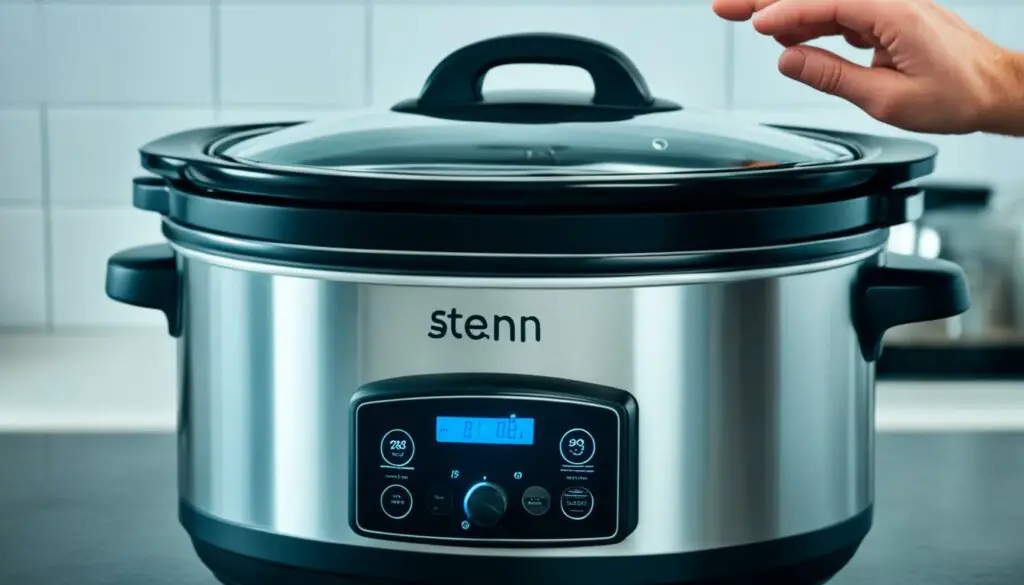
When using a slow cooker, it’s essential to understand how to convert cooking time from low to high settings. This allows you to adjust the cooking process and achieve desired results. The general rule is that the high setting cooks approximately twice as fast as the low setting.
Let’s say your recipe instructs you to cook on low for 6 hours. If you choose to cook on high instead, you can estimate a cooking time of around 3 hours. Similarly, if a recipe calls for 4 hours on high, you can adjust and cook it for 8 hours on low.
It’s important to remember that these are general guidelines that may require some modifications based on your specific slow cooker and recipe. Factors such as size, thickness, and moisture content of ingredients can influence cooking time.
| Original Cooking Time | Conversion to High Setting | Conversion to Low Setting |
|---|---|---|
| 2 hours on low | 1 hour on high | 4 hours on low |
| 4 hours on low | 2 hours on high | 8 hours on low |
| 6 hours on low | 3 hours on high | 12 hours on low |
| 8 hours on low | 4 hours on high | 16 hours on low |
Use the table above as a quick reference guide for converting cooking times in your slow cooker. However, keep in mind that these times may vary depending on the recipe and your specific slow cooker model.
Factors to Consider
When converting a recipe from low to high in a slow cooker, there are a few factors to consider:
- Experiment with your specific slow cooker: Different brands may cook at slightly different temperatures. It’s important to familiarize yourself with your slow cooker’s performance and adjust accordingly.
- Fill the slow cooker adequately: Aim to fill your slow cooker two-thirds of the way with ingredients. This allows for optimal cooking and helps distribute heat more evenly.
- Adjust the amount of liquid: Depending on the original recipe, you may need to make adjustments to the liquid component. If the recipe doesn’t call for liquid, add half a cup of water to the bottom of the crock. If the recipe requires liquid, reduce the amount specified by half.
To ensure successful conversion, take into account these factors when adjusting slow cooker settings, changing slow cooker settings, altering slow cooker settings, or modifying slow cooker temperature. Experiment, fill the slow cooker appropriately, and make necessary adjustments to the recipe’s liquid component.
| Factors to Consider | Recommendations |
|---|---|
| Experiment with your specific slow cooker | Different brands may cook at slightly different temperatures. Get to know your slow cooker’s individual quirks and adjust accordingly. |
| Fill the slow cooker adequately | Aim to fill the slow cooker two-thirds of the way with ingredients. This ensures optimal cooking and heat distribution. |
| Adjust the amount of liquid | If the recipe doesn’t call for liquid, add half a cup of water to the bottom of the crock. If the recipe requires liquid, reduce the amount by half. |
Tips for Successful Conversion

To ensure successful conversion of a slow cooker recipe from low to high, there are a few additional tips to keep in mind:
1. Chop fruits and vegetables evenly
When converting a recipe, it’s essential to chop your fruits and vegetables into the same shape and size. This helps ensure even cooking and consistent results.
2. Add softer produce towards the end
If your recipe includes both soft and tough fruits or vegetables, consider adding the softer ones towards the end of the cooking time. This prevents them from becoming too mushy or overcooked.
3. Searing or browning meats
For added flavor and texture, try searing or browning meats on the stovetop before adding them to the slow cooker. This step enhances the taste and appearance of the final dish.
4. Timing for milk products
When a recipe calls for milk products, such as cream or cheese, it’s best to add them during the last 30 to 60 minutes of cooking. This prevents curdling and ensures a smooth, creamy result.
Tip: The image below visually demonstrates the process of adjusting slow cooker settings for successful recipe conversion.
5. Consider recipe modifications
Depending on your specific recipe and personal taste preferences, you may want to make additional modifications. For example, adjusting the seasoning or adding additional ingredients can enhance the flavor profile of the dish.
By following these tips, you can confidently alter slow cooker settings and modify cooking times to convert your favorite recipes. Remember to experiment and adjust based on your specific slow cooker and desired outcomes.
Printable Conversion Chart

To help with converting low heat to high heat in a slow cooker and modifying the slow cooker temperature, you can use a printable slow cooker time conversions chart. This chart provides guidance on converting cooking times and temperatures between the low and high settings of your slow cooker. By referring to this chart, you can easily adjust your recipes and ensure that your meals are cooked to perfection.
Print out the chart and consider laminating it for durability. You can store it in your recipe binder for easy access or tape it to the inside of your kitchen cabinet for quick reference. Having this handy conversion chart at your fingertips will make it simple to modify your slow cooker recipes and achieve the desired results.
Converting Slow Cooker Time and Temperature
Converting cooking times and temperatures in a slow cooker is crucial for adjusting the heat level and achieving the desired outcome. Whether you need to convert from low heat to high heat or vice versa, the printable conversion chart provides clear instructions on how to modify the cooking time and temperature settings. By following the recommended adjustments, you can confidently convert your recipes without worrying about overcooking or undercooking your meals.
Simple and Convenient Conversion
The printable slow cooker time conversions chart simplifies the process of modifying slow cooker temperatures. Instead of guessing the appropriate adjustments, the chart provides specific guidance for converting cooking times and temperatures. With this tool, you can confidently modify your slow cooker recipes and achieve the desired heat level and cooking time for your meals.
Extend Cooking Time on Short-Cooking Recipes

In some instances, you may come across slow cooker recipes that have shorter cook times than you desire. Don’t worry, though. You have the flexibility to extend the cooking time on these recipes to better fit your schedule. By adjusting the cooking time and temperature settings, you can ensure that the dish is fully cooked and ready to enjoy at the desired time.
When dealing with short-cooking recipes in a slow cooker, there are a few adjustments you can make:
- Increasing the cooking time: Simply lengthen the cooking time specified in the original recipe. Add an extra hour or two to ensure that the ingredients are fully cooked and tender.
- Lowering the temperature setting: If the original recipe calls for a high temperature setting, consider using the low setting instead. This will allow the ingredients to cook more slowly and thoroughly.
Keep in mind that when extending the cooking time on short-cooking recipes, it’s essential to monitor the dish’s progress. While slow cooker recipes are designed to cook slowly, adjusting the cooking time may affect the overall result. It’s always a good idea to check the tenderness and doneness of the ingredients before serving.
Remember, the beauty of using a slow cooker is its flexibility. You have the power to modify cooking times and adapt recipes to suit your individual needs. With a little experimentation and practice, you can confidently adjust the cooking time on short-cooking recipes and create delicious meals that are perfectly timed for your schedule.
Expert Tip:
“Extending the cooking time on short-cooking recipes can be a great way to fit your slow cooker meals into your busy schedule. Just remember to allow for enough time to ensure that the ingredients are fully cooked and tender. Making small adjustments to the cooking time and temperature setting can make a big difference in the final result.” – Chef Emily Johnson
Converting High Cook Time to Low Cook Time
When adjusting slow cooker recipes that originally call for a high cook time, you can modify the cooking time to a longer duration on the low setting. For instance, if a recipe recommends cooking on high for 3 hours, you can extend the cook time to 7 hours on low. Similarly, if a recipe suggests cooking on high for 8 hours, you can cook it for up to 12 hours on the low setting. However, it’s crucial to remember that when converting shorter cook times, you should ensure that the internal temperature of meat is fully cooked and safe to consume.
To guarantee that your meal is cooked to perfection, use a meat thermometer to check the internal temperature. According to the USDA, the safe minimum internal temperature for most meats is 145°F (63°C) with a three-minute rest time.
When to Use Short-Cooking Recipes
While extending the cooking time on short-cooking recipes is helpful for fitting them into your schedule, it’s also important to consider when to use these recipes. Shorter cook times may be ideal for weekends or when you are able to be around the house. By preparing these recipes during times when you have more availability, you can still enjoy the convenience of a slow cooker meal without worrying about the extended cooking time.
Conclusion
Converting slow cooker recipes from low to high heat is a simple process that can be done by adjusting the cooking time and temperature settings. By following the guidelines provided and considering factors such as your specific slow cooker model and recipe requirements, you can seamlessly modify your favorite recipes for flexible cooking times and quick meals. Experiment with different adjustments to find the perfect balance for your desired results.
When adjusting the cooking time, remember that the high setting cooks approximately twice as fast as the low setting. Use this as a general guide, but be sure to consider the specific characteristics of your slow cooker and the recipe you are working with. It’s important to note that you may need to check the internal temperature of meat to ensure it is fully cooked when converting shorter cook times.
Take advantage of the convenience and versatility of your slow cooker by exploring new recipes and techniques. Altering slow cooker settings allows you to create a wide variety of dishes and adapt them to your schedule. Whether you’re converting low heat to high heat or adjusting the heat level and cooking time, your slow cooker offers the flexibility to meet your culinary needs. Enjoy the delicious and effortless meals that can be achieved with the right adjustments in your slow cooker.
FAQ
Can I change a slow cooker recipe from low to high?
Yes, you can easily convert a slow cooker recipe from low to high by adjusting the cooking time and temperature.
How do I adjust the slow cooker settings?
To adjust the slow cooker settings, simply switch from low to high temperature or vice versa.
How can I modify the cooking time in a slow cooker?
To modify the cooking time in a slow cooker, follow the general rule that the high setting cooks about twice as fast as the low setting.
What factors should I consider when converting a recipe from low to high in a slow cooker?
When converting a recipe, consider your specific slow cooker, the amount of ingredients, and the required amount of liquid in the recipe.
What are some tips for successfully converting a slow cooker recipe from low to high?
Chop fruits and vegetables into consistent sizes, add softer produce towards the end of cooking, add milk products during the last 30 to 60 minutes, and consider searing or browning meats before adding them to the slow cooker.
Is there a printable conversion chart available for slow cooker recipes?
Yes, a printable slow cooker time conversions chart is available to help you convert cooking times and temperatures between low and high settings.
Can I extend the cooking time on short-cooking recipes in a slow cooker?
Yes, you can extend the cooking time by adjusting the cooking time and temperature settings on a slow cooker.
How do I convert a high cook time recipe to a low cook time in a slow cooker?
To convert a high cook time recipe to a low cook time, adjust the cooking time to a longer duration on low.
When should I use short-cooking recipes in a slow cooker?
Short-cooking recipes are best used during times when you have more availability, such as weekends or when you can be around the house.
What are some key points to keep in mind when converting slow cooker recipes from low to high?
Keeping your specific slow cooker, recipe requirements, and cooking adjustments in mind will help you seamlessly modify your favorite recipes for flexible cooking times and quick meals.


